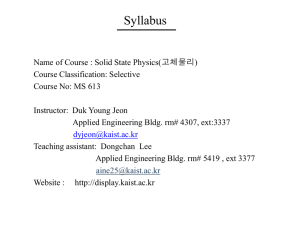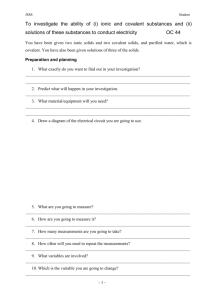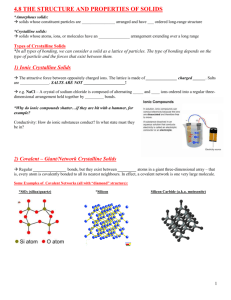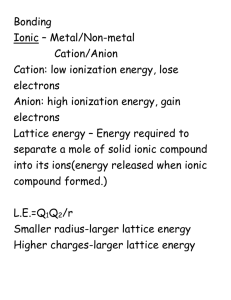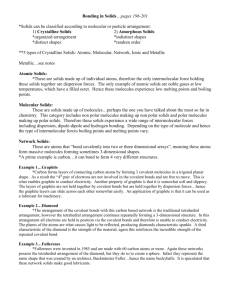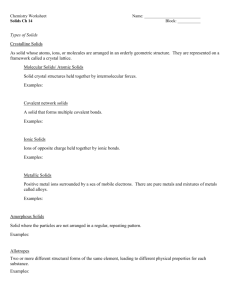THE STRUCTURE OF SOLIDS
advertisement
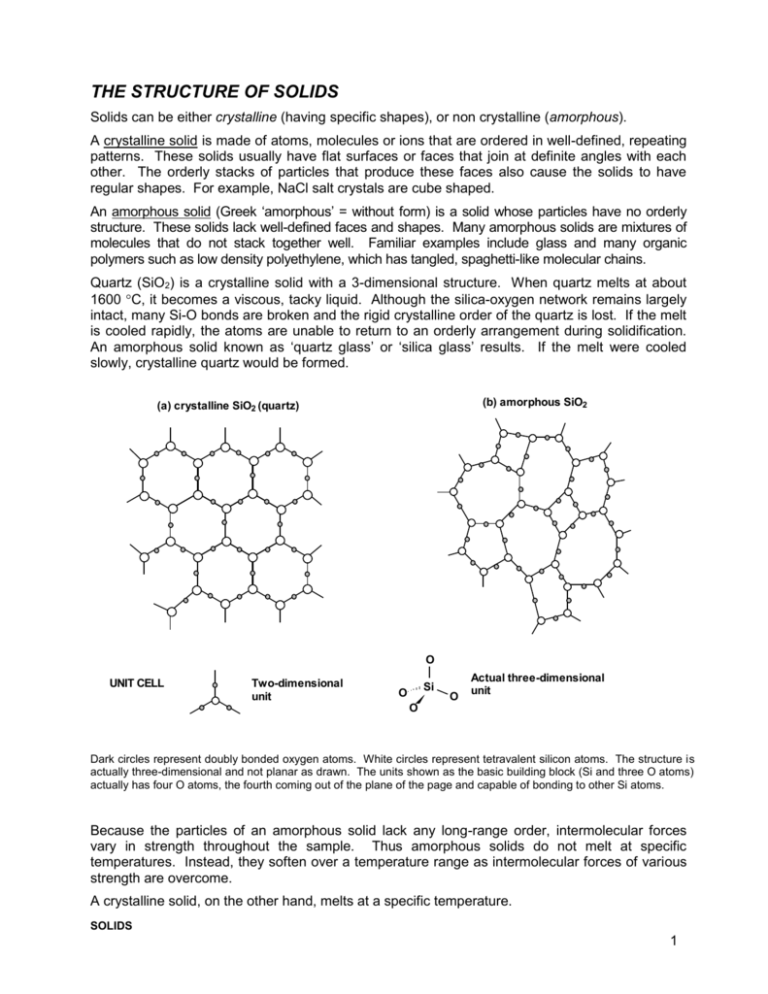
THE STRUCTURE OF SOLIDS Solids can be either crystalline (having specific shapes), or non crystalline (amorphous). A crystalline solid is made of atoms, molecules or ions that are ordered in well-defined, repeating patterns. These solids usually have flat surfaces or faces that join at definite angles with each other. The orderly stacks of particles that produce these faces also cause the solids to have regular shapes. For example, NaCl salt crystals are cube shaped. An amorphous solid (Greek ‘amorphous’ = without form) is a solid whose particles have no orderly structure. These solids lack well-defined faces and shapes. Many amorphous solids are mixtures of molecules that do not stack together well. Familiar examples include glass and many organic polymers such as low density polyethylene, which has tangled, spaghetti-like molecular chains. Quartz (SiO2) is a crystalline solid with a 3-dimensional structure. When quartz melts at about 1600 C, it becomes a viscous, tacky liquid. Although the silica-oxygen network remains largely intact, many Si-O bonds are broken and the rigid crystalline order of the quartz is lost. If the melt is cooled rapidly, the atoms are unable to return to an orderly arrangement during solidification. An amorphous solid known as ‘quartz glass’ or ‘silica glass’ results. If the melt were cooled slowly, crystalline quartz would be formed. (b) amorphous SiO2 (a) crystalline SiO2 (quartz) O UNIT CELL Two-dimensional unit Si O O Actual three-dimensional unit O Dark circles represent doubly bonded oxygen atoms. White circles represent tetravalent silicon atoms. The structure is actually three-dimensional and not planar as drawn. The units shown as the basic building block (Si and three O atoms) actually has four O atoms, the fourth coming out of the plane of the page and capable of bonding to other Si atoms. Because the particles of an amorphous solid lack any long-range order, intermolecular forces vary in strength throughout the sample. Thus amorphous solids do not melt at specific temperatures. Instead, they soften over a temperature range as intermolecular forces of various strength are overcome. A crystalline solid, on the other hand, melts at a specific temperature. SOLIDS 1 TYPES OF CRYSTALLINE SOLIDS BASIC UNITS FORCES BETWEEN UNITS PROPERTIES EXAMPLES ATOMIC non metal atoms London dispersion soft, low mp, poor thermal & electrical conductors Noble gases (frozen Ar) MOLECULAR molecules London, dipole-induced dipole, dipole-dipole, H-bonding soft, low to medium mp, poor thermal & electrical conductors CH4, I2, CO2, sucrose (C12H22O11) IONIC + & - ions ion-ion electrostatic attraction hard, brittle, high mp, poor thermal & electrical conductors NaCl, CaCO3 COVALENT NETWORK covalently bonded atoms covalent bonds v. hard, v. high mp, poor thermal & electrical conductors diamond (C), quartz (SiO2), silica (SiO2), SiC, BN METALLIC metal atoms metallic bonds soft to hard, low to v. high mp, excellent thermal & electrical conductors, malleable & ductile Cu, Fe, Al, alloys (brass, bronze) Atomic Crystals: Individual atoms held together by weak interatomic dispersion forces form an atomic solid. The noble gases (Group 8A) are the only examples of atomic solids. Their melting and boiling points and heats of evaporation and fusion are all very low, rising smoothly with increasing atomic mass. He Ne Ar Kr Xe bp (C) -269 -246 -186 -152 -62 mp (C) -272 -249 -189 -157 -71 Molecular Crystals: In molecular crystals, the units are molecules. For example, in a crystal of iodine, the units are I2 molecules, held together by weak London forces. As a result, molecular solids are usually low melting (below 300C). In a crystal of ice, the units are H2O molecules held together by the strongest kind of van der Waals forces (Hydrogen bonding). Molecular solids have a wide range of physical properties. F2 Cl2 Br2 I2 bp (C) -188 -35 59 184 mp (C) -220 -101 -7 114 In the elemental molecules, EN between atoms is 0.0, so only London forces are present, however in non elemental molecules molecular dipoles create additional intermolecular forces and mp’s and bp’s rise accordingly. SOLIDS 2 Name Formula mp (C) intermolecular force oxygen O2 -219 London sulfur S8 119 London n-butane C4H10 -138 London sulfur dioxide SO2 -73 dipole-dipole water H2O 0 H-bonding phenol C6H5OH 43 H-bonding Ionic Crystals: In crystalline ionic solids, the unit cells contain two kinds of ions; cations (+) and anions (-). Electrostatic attraction between oppositely charged particles is strong. As a result, ionic crystals are hard and have unusually high mp’s (usually greater than 300C). mp (C) NaF NaCl KI CaO 992 801 677 2590 Ionic crystals are brittle (shattered by strong impact) because when one layer of an ionic crystal is pushed past another, like charges are forced together. The strong electrostatic repulsions cause the crystal to fly apart. IONIC SOLIDS + + + + + + + - + + + + + + + - + + + + + + + + + + + - + + + + + + + - + + + + + + + + + + + - + + + + + + + - + + + + electrostatic repulsion causes cleavage Force Electrostatic attraction between alternating rows of anions & cations hold the ions in fixed positions. Ionic solids are hard but brittle. When struck with sufficient force, layers of ions are forced past each other so that like charges are immediately adjacent. Electrostatic repulsion of like charges causes the ionic solid to cleave (split). Because the ions are fixed in position in the crystal and can only vibrate, ionic solids do not usually conduct heat or electricity. However, when melted or dissolved, their ions become mobile and conduct heat and electricity well. Liquids near their freezing points are called melts. SOLIDS 3 Covalent Network Solids: In covalent network solids, few separate particles are present. The units are atoms linked together by strong covalent bonds. Because covalent bonds are strong, these solids are hard, high melting solids. Diamond and graphite are examples of covalent network solids. They are allotropes of carbon, that is, they are different forms of the same element under the same conditions of temperature and pressure. In graphite, sp2 hybridized carbon atoms form a planar (2-dimensional) network of six membered rings. So many resonance structures can be drawn for the network solid that the electrons of each ring are effectively delocalized and spread out over the entire sheet. This is why graphite is black. A graphite electron can absorb the energy of almost any photon of light. This also explains why graphite conducts electricity along the direction of the sheet. An important use of graphite is as electrical contacts (‘brushes’) in motors. The covalent bonds within each sheet are strong but the sheets are held together only by weak dispersion forces. As a result, the sheets readily slide past each other and allow graphite to act as a dry lubricant and the agent in ‘lead pencils’. Diamonds are also built of six membered rings but here each tetrahedral C atom is sp3 hybridized and bonded to 4 other C atoms by bonds giving a non planar 3-dimensional network. C to C bonds are replaced by C to C bonds between C atoms of adjacent sheets. This cross linking of sheets has several important effects. Diamonds are hard – sheets do not slide past each other. Diamonds are the hardest solids known and are used industrially as abrasives. Diamonds are denser than graphite (3.5 vs. 2.2 g/cm3). Diamonds are higher melting, colorless when pure and non conductors of electricity. C to C covalent bond Length = 1.42Å C to C covalent bond Length = 1.54Å Distance between planes = 3.40Å Dispersion forces between hexagonal sheets DIAMOND: a 3-D Covalent Network Solid (all C's have four sp 3 bonds) GRAPHITE: 2-D sheets (all C's have three sp 2 bonds and one bond) ( bonds are not shown) SOLIDS 4 A third allotrope of carbon discovered in 1985 (yellow spherical carbon) has a molecular arrangement shaped like a geodesic dome (soccer ball), called ‘buckminister fullerene’ – ‘buckyballs’ for short. In 1991, a 4th allotrope of carbon was discovered-concentric hollow tubes formed from graphitelike sheets capped with fullerene-like hemispheres of carbon. These tubes (called ‘c-nanotubes’) are only nanometers in diameter but are up to microns in length. In 1995, a 5th allotrope was reported consisting of chains of sp hybridized carbon atoms. Silicates such as quartz (SiO2) exist in a variety of extended covalent networks. Ceramics and many igneous rocks are composed of silicates. Crosslinked polymers such as Bakelite (phenolic) and epoxy adhesives are covalently bonded networks. THE MOHS HARDNESS SCALE German minerolagist Fredrick Mohs (1773-1839) developed a numerical ‘hardness scale’ for identifying minerals with 1 as softest and 10 as hardest. The scale is shown below. 1. talc [Mg3Si4O10(OH)2] 6. orthoclase feldspar (KAlSi3O8) 2. gypsum (CaSO42H2O) 7. quartz (SiO2) 3. calcite (CaCO3) 8. topaz [Al2SiO4(F,OH)2] 4. fluorite (CaF2) 9. corundum (Al2O3) 5. apatite [Ca5(PO4)3(F,Cl,OH)] 10. diamond (C) These minerals were chosen because they are readily available (with the exception of diamond). Each mineral in the Mohs scale can scratch any mineral with the same or a lower number, and can itself be scratched by any mineral with the same or higher number. For example, if an unidentified specimen is scratched by all the hardest minerals down to and including apatite (hardness 5) but not by fluorite (hardness 4), it may be assigned a hardness value of 4½. Often crude equipment is used to perform the hardness (scratch) testing, e.g., a fingernail (hardness 2½), a penny (3), a knife blade or fragment of window glass (5½ - 6), a hardened steel file (7+) or emery cloth (between 8 & 9). The numbers are somewhat arbitrary. Diamond, the hardest known substance, is about four times as hard as corundum (hardness 9). Most valuable gems are at least as hard as quartz (7); anything softer is liable to be damaged quickly if worn as jewelry. Sapphire and ruby (varieties of corundum) have a Mohs hardness of 9. Graphite has a Mohs hardness of 1-2. DIAMOND FILMS: In the 1950’s, synthetic diamonds were made slowly and expensively by exposing graphite to extreme temperatures (ca. 1400 ºC) and pressures (50,000 atm). In the 1960’s the process of ‘Chemical Vapor Deposition’ (CVD) was developed. A stream of methane (CH4) breaks down at moderate temperatures (ca. 600 ºC) and low pressure (0.001 atm) and the carbon atoms deposit on the surface at rates to 100 m per hour. Because of diamond’s incredible hardness and high thermal conductivity, this process is currently being applied to manufacture scratch proof cookware, watch crystals, hard discs, eyeglasses, lifetime drill bits, ball bearings, razor blades and semiconductors. SOLIDS 5 THE STRUCTURE OF CRYSTALS All crystals contain regularly repeating arrays of atoms, molecules, or ions (analogous to the repeating patterns in wallpapers, but in 3-D rather than 2-D). The smallest unit of volume of a crystal that shows all characteristics of a crystal’s growth is a ‘unit cell’. The unit cell is described by the length of its edges – a, b, c (the spacing between layers) and the angles between the edges - , , . Unit cells are stacked in 3-dimensions to build a ‘crystallatice’. All unit cells fit into one of seven crystal systems. Primitive (simple) unit cells of the seven crystal systems are shown below. THE PRIMITIVE (SIMPLE) UNIT CELLS OF THE SEVEN CRYSTAL SYSTEMS c Generic Unit Cell b Monoclinic (1 tilt) lengths: a <> b <> c angles: = = 90º, <> 90º e.g., CaSO4.2H2O (gypsum) Cu2CO3(OH)2 (malachite) a Cubic (Isometric) lengths: a = b = c angles: = = = 90º e.g., NaCl (rock salt) CaF2 (fluorite) FeS2 (pyrite) Tetragonal (shoe box) lengths: a = b <> c angles: = = = 90º e.g., MnO 2 (pyrolusite) TiO2 (rutile) Orthorhombic (match box) lengths: a <> b <> c angles: = = = 90º e.g., MgSO 4.7H2O (epsomite) BaSO4 (barite) Triclinic (3 tilts) lengths: a <> b <> c angles: <> <> <> 90º e.g., K2Cr 2O7 (potassium dichromate) Rhombohedral lengths: a = b = c angles: = = <> 90º e.g., CaCO3 (calcite) Hexagonal lengths: a = b <> c angles: = = 90º, = 120º e.g., SiO2 (silica, i.e., quartz) Fe2O3 (hematite) SOLIDS 6 Each unit cell has variations. For example, cubic, octahedral, and dodecahedral crystals are all variations of an isometric unit cell (a = b = c, = = = 90º) obtained by cutting sections of faces off the unit cell. Different substances that crystallize in the same crystallatice type are said to be ‘isomorphic’. For example, fluorite and pyrite are isomorphic (both are cubic). A single substance that can crystallize in more than one arrangement is said to be ‘polymorphic’. For example, CaCO3 is polymorphic. It is commonly found in two crystalline forms: calcite (rhombohedral) and aragonite (orthorhombic). In solid rock, grains interfere with one another’s growth so that they cannot take the macroscopic shape they would like to take. Instead, they fill in whatever hole is available. So grains of rock have only internal (microscopic) crystal structure, which is identified by X-ray diffraction. Minerals that grow slowly in open cavities or water-filled pockets are free to form large perfect crystals identical to the shape of each of the tiny unit cells. Metallic Crystals: Metallic crystals (metals and alloys) and The Electron Sea Model The bonding in metals is neither covalent nor ionic. The electron sea model proposes that all metal atoms in the sample contribute their valence electrons to form a ‘sea of electrons’, which is delocalized throughout the solid. The metal ions (nuclei with their core of inner electrons) are submerged in and held together in an orderly array in this sea of electrons. Electron Sea Model of Metals + + + + + + + + + + + + + + + + + + + + + piece of metal sea of valence electrons metal atom nucleus with inner electrons In contrast to ionic bonding, the metal ions are not held in fixed positions. In contrast to covalent bonding, no particular pair of metal atoms is bonded through any delocalized pair of electrons. Rather the valence electrons are shared among all the atoms in the substance. Valence electrons are free to move explaining the thermal and electrical conductivity of metals in both the liquid and solid states. If you place your hand on a piece of metal and a piece of wood (both at room temperature), the metal feels colder because it conducts heat away from your body much faster than wood. The electrical conductivity of metals is inversely related to temperature. With increasing temperature, metal ions vibrate more and disrupt the electron flow through the substance. SOLIDS 7 Melting and boiling points of metals: Electrostatic attractions between metal cations and valence electrons are not broken when metals melt so the mp of metals are only moderately high. Boiling a metal does require breaking these attractions so boiling points are quite high (as seen in the following table). mp (C) bp (C) Li 180 1347 Sn 232 2632 Al 660 2467 Ga 30 2403 Ag 961 2155 Alkaline Earth metals (Group 2A) have significantly higher mp’s than the Alkali metals. This can be explained by the fact that Group 2A metals have twice as many valence electrons for metallic bonding. All metals, with the exception of Cu and Au, are silver colored when polished or cut smoothly. Absorption of photons of all kinds of electromagnetic radiation by the mobile valence electrons and reemission of the energy as light is said to cause this. Metals are malleable and ductile. For example, 1 gram of Au (the size of a small ball bearing) can be drawn into a wire 20m thick 165 m long (ductile) and hammered into a 1.0 m2 sheet only 230 atoms (70 m) thick (malleable). The electron sea model explains this behavior as metal ions sliding through a paste of electrons. Alloys Irregularities (impurities) often make metals tougher and less workable. For example: Brass (a 60:40 alloy of Cu and Zn) is harder and higher melting than Cu or Zn. Bronze (a 90:10 alloy of Cu and Sn) is harder than Cu and Sn and was originally used to make weapons and tools (‘Bronze Age’). Carbon steel (an alloy of Fe, C, Mn, Cr, and Ni) is much stronger and stiffer than Fe alone. Pure Au (24-carat) is soft and easily dented, however, when alloyed with 42% Ag (14-carat) it is harder, cheaper, and more durable in jewelry without a noticeable difference in color compared to pure Au. Doping: The electrical conductivity of semiconductors such as Si and Ge is greatly enhanced by doping – adding trace amounts of Group 3A (Ga) or 5A (P) elements. The addition of P creates n-type semiconductors – so called because of the extra non bonded electron in Group 5A elements. The addition of Ga creates a p-type semiconductor – so called because of the empty p orbitals in Group 3A elements. By joining n and p-type semiconductors, diodes (AC to DC rectifiers) and triode (transistors) are produced for many kinds of electronic equipment (computers, TV, radios, telephones, etc.). SOLIDS 8 SELF-STUDY QUESTIONS FOR UNIT ON SOLIDS: 1. A crystalline solid is made of …………………… , ……………………., or …………………….. arranged in …………………………………….. . These solids usually have ………………… surfaces that join at …………………………….. . 2. Write chemical formulas of 5 different crystalline solids (you may need to read all 8 pages before you can complete this question). a) ………………………….. d) ………………………….. b) …………………………. e) ………………………….. c) ………………………….. 3. An amorphous solid has no ……………………………….. . 4. Give 3 specific examples of amorphous solids a) …………………………. c) ………………………….. b) ………………………….. 5. The repeating unit of quartz has a …..-dimensional structure. The chemical formula of its simplest repeating unit is …………………. . When cooled quickly from the melt, silica forms a substance commonly called …………….. …………………… . 6. State the relative difference in the melting points of crystalline versus amorphous solids …. …………………………………………………………………………………………………………. . 7. Complete the following table Type of Crystalline Solid Basic Unit Forces Between Units (List all types) Example (Chemical Formula) Relative Hardness (low, medium, high) Relative mp (low, medium, high) 8. Noble gases are the only examples of solids called …………………… crystals. The type of force between Noble gases is called …………………………. . Describe the relationship between mp and MW of the Noble gases. ………………………………………………………… …………………………………………………………………………………………………………. . 9. Water and carbon dioxide are examples of compounds that form crystalline solids called …………………….. ……………………………….. . Such compounds typically exhibit mp’s below ……………… °C. SOLIDS 9 10. List 3 types of forces that can exist between molecules in molecular solids and list the chemical formula of an example of each. a) ……………………………………… ……………………………….. c) ………………………………………. ……………………………….. b) ……………………………………….. ………………………………… 11. Ionic crystals typically exhibit mp’s above …………..°C. 12. Explain why ionic crystals are hard but brittle (2 aspects/reasons) ……………………………. …………………………………………………………………………………………………………… ………………………………………………………………………………………………………….. . 13. Define a ‘melt’ and give an example ………………………………………………………………. …………………………………………………………………………………………………………. . 14. With respect to covalent network solids: a) describe their mp’s. relative to other types of solids …………….………………… b) describe their hardness relative to other types of solids ……………………….………….. 15. List the chemical formulas of the repeating unit of 4 different covalent network solids a) ……………………………………. c) …………………………………….. b) …………………………………….. d) ……………………………………….. 16. Define allotrope ………………………………………………………………………………………. 17. List 3 allotropes of carbon ……………………… ,………………………., ………………………. 18. Name the hybridization state of Carbon in: a) graphite ………………………. b) diamond ……………………… 19. Explain how graphite can act as: a) an electrical conductor ……………………………………………………………………….. b) a dry lubricant ………………………………………………………………………………… 20. State which is greater (diamond or graphite) with respect to: a) density ……………….. c) mp ………………………. b) hardness ……………… d) electrical conductivity ……………. 21. List 2 industrial applications of diamond (other than in jewelry). a) …………………………………………… b) ……………………………………………… 22. State the Mohs hardness number corresponding to the following: a) diamond e) Cu penny b) talc f) c) quartz g) emery paper glass/knife blade d) fingernail SOLIDS 10 23. The smallest repeating unit of a crystalline solid is called a ……………. These are stacked together in a ……………………………………… .. ………………… . 24. Name the 3 primitive unit cells whose angles between edges are all 90°C. a) …………………………………………………… b) ………………………………………………….. c) …………………………………………………… 25. Explain the meaning of the word a) monoclinic ………………………………………. b) triclinic …………………………………………… 26. The unit cell with all sides equal length but not all angles equal is called …………………….. . 27. Draw the hexagonal unit cell. 28. Explain what is meant when 2 substances are said to be ‘isomorphic’. ……………………….. …………………………………………………………………………………………………………. . 29. List 2 substances that are isomorphic. …………………………………………………………….. 30. Explain what is meant when 1 substance is ‘polymorphic’………………………………………… …………………………………………………………………………………………………………. . 31. List 2 substances that are polymorphic. …………………………………………………………. 32. Describe the conditions under which minerals naturally grow near perfect crystals. ………………………………………………………………………………………………………… …………………………………………………………………………………………………………. 33. Name the model describing bonding in metals …………………………………………….. . 34. Explain why metals have high electrical and thermal conductivity …………………………. …………………………………………………………………………………………………………. . 35. Heating a metal causes its electrical conductivity to increase or decrease (circle one). 36. The electrical resistance of metal increases or decreases as it cools (circle one). 37. Give the chemical symbols of the two elements in a bronze alloy. a) ………………………………………… b) ………………………………………….. 38. Give the chemical symbols of the two elements in a brass alloy. a) ………………………………………… b) ………………………………………….. 39. List 3 elements alloyed with Fe and C in carbon steel ……………………………………. 40. Give the name and symbol of the element commonly alloyed with gold in jewelry. 41. Semiconductors such as …………….. and ………………….. are doped with trace quantities of elements from Group ……………A such as ……………… or from Group ……..A such as ………….. 42. How is the electrical conductivity of a semiconductor affected by doping? ……………………………………………………………………………………………………………. SOLIDS 11

